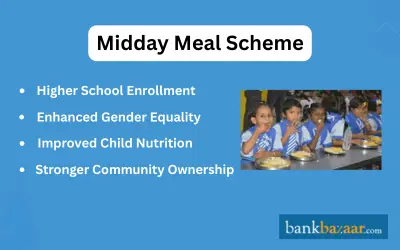Midday Meal Scheme
What is the Midday Meal Scheme?
The Midday Meal Scheme is a government initiative by the Ministry of Education, aimed at improving the nutritional status of school-aged children across India. Under this scheme, free lunches are provided on working days to children in primary and upper primary classes in government, government-aided, and local body schools.
Launched nationwide in 1995, the scheme plays a vital role in enhancing school enrollment, retention rates, and nutritional standards among children.

Objectives of the Midday Meal Scheme
- Improve nutritional levels of children.
- Encourage school attendance and reduce dropout rates.
- Promote social equality by allowing children from all backgrounds to eat together.
- Create employment opportunities for local cooks, helpers, and suppliers.
- Enhance educational performance by addressing classroom hunger.
Beneficiaries of the Scheme
The scheme targets:
- Children aged 6 to 14 years
- Enrolled in Classes 1 to 8
- Studying in:
Government schools
Government-aided schools
Local body-run schools
Special Training Centres under the Education Guarantee Scheme
- Government schools
- Government-aided schools
- Local body-run schools
- Special Training Centres under the Education Guarantee Scheme
Nutritional Norms of the Midday Meal Scheme
Class | Energy (kcal) | Protein (g) | Food Grains (g) | Pulses (g) | Vegetables (g) | Oil & Fat (g) |
I-V | 450 | 12 | 100 | 20 | 50 | 5 |
VI-VIII | 700 | 20 | 150 | 30 | 75 | 7.5 |
Features of the Scheme
- Cooked meals are provided free of cost.
- Involves community participation and local procurement.
- Meals are prepared in school premises or through centralized kitchens.
- Menu diversity is encouraged for regional and seasonal adaptation.
- The scheme is funded jointly by the Central and State governments.
Key Achievements of the Scheme
- Increase in school enrollment and attendance.
- Improved gender equality in education.
- Better child nutrition indicators, especially in rural and underprivileged areas.
- Community ownership and participation have improved transparency and accountability.
Changes and Revamp: PM POSHAN
In 2021, the Midday Meal Scheme was renamed as PM POSHAN (Pradhan Mantri Poshan Shakti Nirman).
Key features under PM POSHAN:
- Includes pre-primary children in government schools.
- Focuses on nutritional gardens in schools.
- Promotes Tithi Bhojan, where the community contributes meals during festivals.
- Incorporates use of millets and locally sourced grains.
Midday Meal Scheme – Government Budget & Funding
- The scheme is a Centrally Sponsored Scheme (CSS).
- Fund-sharing ratio:
90:10 for North Eastern states, hilly regions
60:40 for other states
100% central funding for UTs without legislature
- 90:10 for North Eastern states, hilly regions
- 60:40 for other states
- 100% central funding for UTs without legislature
Challenges in Implementation
Despite its success, the scheme faces issues like:
- Poor quality of meals in some regions
- Delayed fund transfers and supply disruptions
- Lack of infrastructure like clean kitchens and utensils
- Occasional reports of food poisoning
Monitoring & Evaluation
To ensure transparency and accountability:
- Real-time monitoring using MIS (Management Information System)
- Engagement with School Management Committees (SMCs)
- Random inspections by district and state-level officers
- Third-party evaluations by research institutions
Related Government Initiatives
- Integrated Child Development Services (ICDS)
- National Nutrition Mission (POSHAN Abhiyan)
- Right to Education (RTE) Act
- Samagra Shiksha Abhiyan.
FAQs on Midday Meal Scheme
- What is the Midday Meal Scheme?
The Midday Meal Scheme is a school lunch program initiated by the Indian government to provide free meals to students in Classes 1 to 8.
- When was the Midday Meal Scheme launched?
It was officially launched on 15 August 1995 across India.
- What is PM POSHAN?
PM POSHAN is the revamped version of the Midday Meal Scheme introduced in 2021, with added features like nutritional gardens and inclusion of pre-primary children.
- Who benefits from the Midday Meal Scheme?
Children enrolled in Classes 1 to 8 in government, government-aided, and local body schools.
- How is the Midday Meal Scheme funded?
It is a centrally sponsored scheme with shared funding between the central and state governments.
- What food is served under the Midday Meal Scheme?
Nutritious cooked meals including rice/wheat, pulses, vegetables, and oil/fat, meeting specific caloric and protein guidelines.
- What are the challenges faced in the scheme?
Challenges include poor food quality, infrastructure issues, and logistical delays in certain regions.
- How is the quality of the Midday Meals monitored?
Through regular inspections, MIS-based monitoring, community involvement, and third-party evaluations.
- What are some achievements of the scheme?
Improved nutrition levels, increased school enrollment, especially for girls, and better social integration.
- Is the scheme available in private schools?
No, it is available only for government, government-aided, and local body-run schools.

Disclaimer
Credit Card:
Credit Score:
Personal Loan:
Home Loan:
Fixed Deposit:
Copyright © 2025 BankBazaar.com.